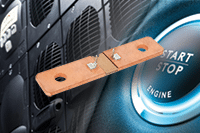source: Vishay news
MALVERN, Pa. — May 24, 2017 — Vishay Intertechnology, Inc. (NYSE: VSH) today announced a new Power Metal Strip® battery shunt resistor featuring two sense pins that offers a 36 W power capacity in the 8518 case size. With extremely low resistance values down to 50 µΩ, the Vishay Dale WSBS8518…20 increases accuracy and lowers costs compared to Hall Effect current sensing solutions, while its sense pins assist in PCB mounting and provide consistent contact point location.
The device released today features a proprietary processing technique that produces extremely low resistance values of 50 µΩ, 100 µΩ, 125 µΩ, and 250 µΩ. These low values allow for more accurate data to determine battery charge and discharge, thus helping designers meet specific customer battery management requirements for applications in gas, diesel, hybrid, and electric cars and trucks, as well as electric forklifts, UPS systems, and other heavy industrial applications.
The WSBS8518…20 features a solid metal manganese-copper alloy resistive element with low TCR (± 20 ppm/°C), and a welded terminal to element connection. The resistor offers low inductance values of < 5 nH, low thermal EMF down to < 1 µV/°C, and an operating temperature range of -65 °C to +170 °C. The device is RoHS-compliant, halogen-free, and Vishay Green.
Samples and production quantities of the WSBS8518…20 are available now, with a lead time of 10 to 12 weeks for larger orders.































